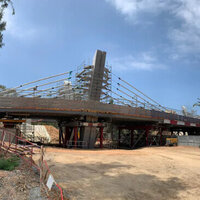Subsidence of the viaduct on 31 December 2015 resulted in serious deformation of the track as the 05:57hrs Crewe to Glasgow passenger rail service passed over at a speed of about 177 km/h. The viaduct spans the River Clyde between Lockerbie and Carstairs. Subsequent investigation showed that the viaduct’s central river pier had been partially undermined by scour following high river flow velocity the previous day. The line was closed for over seven weeks while emergency stabilisation works were completed.
The investigation by UK’s Rail Accident Investigation Branch (RAIB) found that scour was a known risk at the viaduct, but that a project to provide protection had been deferred because of delays in obtaining an environmental permit. It also emerged that a monitoring process to check vulnerable bridges was no longer in place at the time of the failure. Organisational changes within Network Rail had led to a loss of knowledge and ownership of some structural issues, the investigators found.
As a result of the investigation, RAIB has made three recommendations to Network Rail relating to the management of scour risk, the response to defect reports affecting structures over water and the management of control centre procedures.
The viaduct spans a river bend, which causes water to wash against the sides of the piers. It was also known to have shallow foundations. These were among the factors that resulted in it being identified as being at high risk of scour in 2005. A scheme to provide permanent scour protection to the piers and abutments was due to be constructed during 2015, but this project was deferred until mid-2016 because a necessary environmental approval had not been obtained, found RAIB.
To mitigate the risk of scour, the viaduct was included on a list of vulnerable bridges for which special precautions were required during flood conditions. However, the monitoring process was no longer in use and there was no effective scour risk mitigation for over 100 of the most vulnerable structures across Scotland. This had occurred, in part, because organisational changes within Network Rail had led to the loss of knowledge and ownership of some structures issues, found the investigation.
Simon French, chief inspector of rail accidents, said: “It is of particular concern to me that the vulnerability of this structure to scour had been identified at least 10 years previously. Despite this, insufficient action had been taken to protect the piers from scour, or to monitor the integrity of the viaduct at times of high water flow. The continued operation of trains over this high risk structure, despite a previous report from a driver of a rough ride, provides vivid evidence that the risk of scour was not generally appreciated by those involved.
“Of even more concern was our finding that there were no effective scour mitigation measures in place for over 100 of the most vulnerable structures across Scotland. We discovered that a previous process for managing scour risk on Scotland Route had fallen into disuse, at least in part due to organisational change, and that this had not been recognised by Network Rail.”
He added that it is vital that the railway industry finds ways to retain its corporate memory of its assets and the associated management systems.



